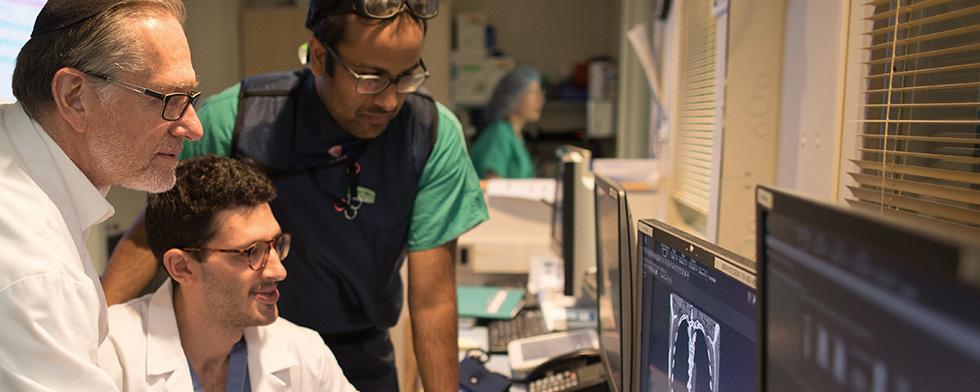Services
Vascular and Interventional Radiology
Vascular and interventional radiology (VIR) allows for safe and effective treatment of many medical conditions that once required invasive surgery and a long recovery period. Compared to traditional surgical options, advanced VIR procedures rarely require general anesthesia and can dramatically reduce a patient's risk, pain, discomfort and cost.
Montefiore radiologists have been and continue to be at the forefront of medical breakthroughs in vascular and interventional radiology to treat patients safely and aggressively with minimally invasive solutions to conditions, such as:
Abdominal Aortic Aneurysm
Imagine a balloon that expands quickly and could break. That is one way to think of an abdominal aortic aneurysm. The large blood vessel (the main artery called the aorta) expands, and if it becomes too large too quickly, the vessel ruptures. Endovascular aortic aneurysm repair (EVAR)—a minimally invasive procedure in which a tube is inserted into the aorta to support it and eventually reduce swelling—addresses this potentially life-threatening condition.
Jacob Cynamon, MD, pioneered EVAR, performing the first ever procedure in the United States alongside our vascular surgeons nearly 25 years ago. Our interventional radiologists continue as leaders in the treatment of endoleaks, the most common complication after an EVAR procedure.
Jaundice, Bile Duct Obstructions and Some Liver Cancers
The Division of Vascular and Interventional Radiology performs difficult and complex percutaneous biliary stenting to treat jaundice, bile duct obstructions and some liver cancers. We work with gastroenterologists and specialized liver surgeons to ensure a minimally invasive approach.
Pulmonary Embolism
A pulmonary embolism is a blood clot that blocks a lung. A small, cone-shaped device called an inferior vena cava (IVC) filter is designed to protect patients from fatal pulmonary embolisms. The filter is placed just below the kidneys and may be removed when it is no longer needed in certain instances.
Uterine Fibroids
Uterine artery embolization (UAE) is a noninvasive and highly effective procedure used to treat uterine fibroids and relieve symptoms, including heavy menstrual bleeding, prolonged periods, pelvic pressure or pain, frequent urination or difficulty urinating.
During a UAE—which does not require general anesthesia or a hospital stay—tiny particles are injected into the arteries feeding the uterus to decrease the blood supply to the fibroids, causing them to shrink.
Cancer
Interventional oncology—a targeted, minimally invasive approach that is especially useful for liver cancer, including cancer that has spread to other parts of the body—delivers treatment directly to tumors, limiting exposure to healthy tissue. Interventional oncology treatments performed at Montefiore include:
- Transarterial Chemoembolization
Chemotherapy agents are injected directly into the blood vessels that supply liver tumors, exposing the tumor to the toxic effects of the treatment but sparing normal liver. This permits a higher dose of chemotherapy to be used. - Yttrium-90 Radioembolization
Radioactive embolic particles are injected into the blood vessels that supply the tumor and are able to deliver local radiation to the tumor while sparing healthy tissue. - Percutaneous Microwave Ablation
This targeted treatment uses heat to kills liver tumors. A small needle is placed through the skin into the tumor using image guidance. The tip of the needle delivers energy to the tumor to produce heat and kill the tumor. - Venous Access—Permacath
Shiley catheter, port-a-cath placement for cancer or other medically related treatment.
Peripheral Vascular Disease (PVD)
Peripheral vascular disease, or peripheral artery disease, is a narrowing or blockage of the vessels in your legs, most commonly from atherosclerosis. This limits blood flow to the muscles and soft tissues in your legs. Some patients will experience muscle aches when they walk; more serious complications include infection or amputation. Noninvasive, nonsurgical treatment options for the treatment of PVD include angioplasty and stenting to open blocked or narrowed vessels and restore blood flow.
Varicoceles
Varicoceles—enlarged veins within the scrotum—which are typically treated with surgery—can be painful and lead to testicular atrophy or infertility. Nonsurgical, minimally invasive, catheter-directed therapy does not require surgical incisions or general anesthesia. The procedure targets the veins, so blood no longer reaches the abnormal veins, shrinking the varicocele. It is just as effective as open surgery.
Dialysis Fistula and Graft Management
Interventional radiologists play an integral role in preserving hemodialysis access and are skilled at fistula or graft declotting, as well as angioplasty and stenting to treat graft and fistula stenosis or nonmaturation. We also perform hemodialysis catheter placement and removal.
Abdominal Fluids or Bleeding Problems
A liver biopsy is when your doctor takes a sample of tissue from your liver to check for any problems. If patients have abdominal fluids or bleeding problems, a transjugular liver biopsy is an option. When biopsy is not an option, an interventional radiologist can perform a transjugular liver biopsy.
Refractory Ascites or Variceal Bleeding
In patients with cirrhosis and portal hypertension, a transjugular intrahepatic portosystemic shunt (TIPS) is a nonsurgical, minimally invasive treatment option. A cirrhotic liver impedes blood flow to the heart, leading to ascites and variceal bleeding. A TIPS procedure creates a narrow tube between the portal vein to carry blood from the intestines and the hepatic veins to return blood to the heart, bypassing the liver.
Balloon-occluded retrograde transvenous obliteration (BRTO) is an alternative to TIPS and is specifically indicated for the treatment of gastric varices with gastro-renal shunts in patients with cirrhosis who have active bleeding from large gastric varices, which are dilated stomach veins.
Varicose Veins
Varicose veins—swollen veins you can see just under the skin—are commonly found in the legs but can be elsewhere. They cause veins aches, throbbing and heaviness that can get worse later in the day. The noninvasive, nonsurgical treatment option for varicose veins is called endovenous ablation, an outpatient procedure that does not require general anesthesia or an hospital stay. This is a form of ultrasound procedure that closes up the affected vein.

